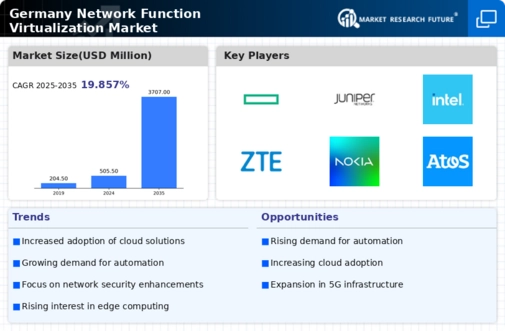The network function-virtualization market in Germany is characterized by a dynamic competitive landscape, driven by rapid technological advancements and increasing demand for efficient network management solutions. Key players such as VMware (US), Cisco (US), and Nokia (FI) are at the forefront, each adopting distinct strategies to enhance their market positioning. VMware (US) focuses on innovation through its cloud-native technologies, aiming to streamline operations for service providers. Cisco (US), on the other hand, emphasizes strategic partnerships and acquisitions to bolster its portfolio, particularly in security and automation. Nokia (FI) is leveraging its strong R&D capabilities to develop next-generation solutions, while also pursuing regional expansion to capture emerging opportunities. Collectively, these strategies contribute to a competitive environment that is increasingly centered around technological innovation and strategic collaborations.
In terms of business tactics, companies are increasingly localizing manufacturing and optimizing supply chains to enhance operational efficiency. The market structure appears moderately fragmented, with several key players exerting influence over various segments. This fragmentation allows for a diverse range of offerings, yet the collective strength of major companies like Ericsson (SE) and Huawei (CN) ensures that competition remains robust. The interplay between these players shapes the market dynamics, as they vie for leadership through differentiated strategies and localized approaches.
In October 2025, Ericsson (SE) announced a strategic partnership with a leading German telecommunications provider to enhance its 5G network capabilities. This collaboration is expected to facilitate the deployment of advanced network functions, thereby improving service delivery and customer experience. The significance of this partnership lies in its potential to position Ericsson (SE) as a key enabler of next-generation connectivity solutions in the region, aligning with the growing demand for high-performance networks.
In September 2025, Cisco (US) launched a new suite of virtualization tools aimed at optimizing network performance for enterprises. This initiative reflects Cisco's commitment to innovation and its strategy to address the evolving needs of businesses in a digital-first world. By enhancing its product offerings, Cisco (US) not only strengthens its competitive edge but also responds to the increasing demand for agile and scalable network solutions.
In August 2025, Huawei (CN) unveiled its latest cloud-based network function virtualization platform, designed to support the growing needs of IoT applications. This development underscores Huawei's focus on integrating advanced technologies into its offerings, positioning the company to capitalize on the burgeoning IoT market. The introduction of this platform is likely to enhance Huawei's competitive stance, particularly in sectors where IoT adoption is accelerating.
As of November 2025, current trends in the network function-virtualization market are heavily influenced by digitalization, sustainability, and the integration of AI technologies. Strategic alliances are increasingly shaping the competitive landscape, as companies recognize the value of collaboration in driving innovation. Looking ahead, it appears that competitive differentiation will evolve, with a notable shift from price-based competition to a focus on technological innovation and supply chain reliability. This transition suggests that companies that prioritize R&D and strategic partnerships will likely emerge as leaders in the market.























Leave a Comment